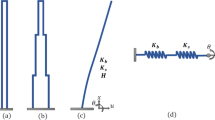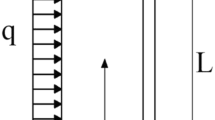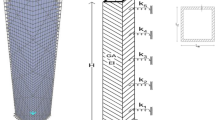Abstract
This article introduces a method for statically analyzing tall buildings using a combination of the continuum method and the transfer matrix method. The approach offers both analytical and numerical solutions, enabling the assessment of critical parameters such as lateral, rotational displacements, and drifts in tall buildings. The continuous model used consists of the parallel coupling of two Timoshenko beams. This model captures the interaction between flexural and shear stiffness, presenting a comprehensive understanding of tall building behavior. Moreover, it incorporates three distinct kinematic fields that encompass both translational and rotational movements. The flexibility of the model enables an expansive analysis across various structural configurations, including frames, shear walls, coupled shear walls, and tall buildings with complex structural systems. The equilibrium equations and essential boundary conditions are obtained by a variational approach based on Hamilton’s principle. For tall buildings with uniform properties along their height, a closed-form solution is proposed, while a numerical solution is presented for structures with varying geometric and structural properties along their height by analytically deriving their transfer matrix. Numerical demonstrations showcase the precision and reliability of the proposed analytical and numerical techniques. Furthermore, the method offers the advantage of reduced processing time, making it particularly suitable for preliminary analysis of tall buildings and serving as a valuable tool for verifying structural integrity and performance in later stages of the project.





















Similar content being viewed by others
References
Chitty L (1947) On the cantilever composed of a number of parallel beams interconnected by cross bars. Lond Edinb Dublin Philos Mag J Sci Ser 7:685–699. https://doi.org/10.1080/14786444708521646
Chitty L and Wan WY (1948) Tall building structures under wind load. In: Proceedings of the 7th International Congress for Applied Mechanics, 22, pp 254–268
Skattum KS (1971) Dynamic analysis of coupled shear walls and sandwich beams, Earthquake Engineering Research Laboratory, California Institute of Technology, Pasadena. https://resolver.caltech.edu/CaltechThesis:10192017-151943526
Rosman R (1973) Dynamics and stability of shear wall building structures. Proc Inst Civ Eng 55:411–423. https://doi.org/10.1680/iicep.1973.4875
Rosman R (1981) Buckling and vibrations of spatial building structures. Eng Struct 4(3):191–202. https://doi.org/10.1016/0141-0296(81)90001-8
Reinhorn A (1978) Static and Dynamic Torsional Coupling in Tall Buildings. In: PhD thesis, Israel Institute of Technology-Israel
Hegedűs I, Kollár LP (1984) Buckling of sandwich columns with thick faces subjecting to axial loads of arbitrary distribution. Acta Technica Scientiarum Hungaricae 97:123–132
Miranda E (1999) Approximate lateral drift demands in multi-story buildings subjected to earthquakes. J Struct Eng 124(4):417–425. https://doi.org/10.1061/(ASCE)0733-9445(2002)128:7(840)
Zalka KA (2002) Buckling analysis of buildings braced by frameworks, shear walls and cores. Struct Design Tall Spec Build 11(3):197–219. https://doi.org/10.1002/tal.194
Hans S (2002) Dynamic auscultation of buildings and modeling by homogenization contribution to the analysis of seismic vulnerability. In: Ph.D. Dissertation, National Institute of Applied Sciences of Lyon
Potzta G, Kollár LP (2003) Analysis of building structures by replacement sandwich beams. Int J Solids Struct 40(3):535–553. https://doi.org/10.1016/S0020-7683(02)00622-4
Bozdogan KB, Ozturk D, Nuhoglu A (2007) An approximate method for static and dynamic analyses of multi-bay coupled shear walls. Struct Design Tall Spec Build 18(1):1–12. https://doi.org/10.1002/tal.390
Zalka KA (2007) A simple method for the deflection analysis of tall wall-frame building structures under horizontal load. Struct Design Tall Spec Build 18(3):291–311. https://doi.org/10.1002/tal.410
Kaviani P, Rahgozar R, Saffari H (2008) Approximate analysis of tall buildings using sandwich beam models with variable cross-section. Struct Design Tall Special Build 17:401–418. https://doi.org/10.1002/tal.360
Bozdogan KB, Ozturk D (2010) An approximate method for lateral stability analysis of wall-frame buildings including shear deformations of walls. Sadhana 35(3):241–253. https://doi.org/10.1007/s12046-010-0008-y
Chesnais C (2010) Dynamics of unbraced reticular media: application to buildings. In: Ph.D. Dissertation, Central School of Lyon
Bozdogan KB (2010) Static, dynamic and stability analyses of multi storey building using transfer matrix method. In: Ph.D. Dissertation, Ege University
Zalka KA (2013) Maximum deflection of symmetric wall-frame buildings. Periodica Polytechnica Civ Eng 2(57):173–184. https://doi.org/10.3311/PPci.7172
Moghadasi H (2015) Replacement beam methods in analysis of tall building structural systems. In: Ph.D. Dissertation, Politecnico di Milano
Laier JE (2021) An improved continuous medium technique for three-dimensional analysis of tall building structures. Struct Eng Mechan 80(1):73–81. https://doi.org/10.12989/sem.2021.80.1.073
Franco C (2021) Modélisation multi-échelle de la réponse seismique des bâtiments: couplage homogénéisation et éléments multifibras. In: Ph.D. Dissertation, Université Gustave Eiffel
Franco C, Chesnais C, Semblat JF, Giry C, Desprez C (2022) Finite element formulation of a homogenized beam for reticulated structure dynamics. Comput Struct. https://doi.org/10.1016/j.compstruc.2021.106729
Pinto MC (2023) Closed-form and numerical solution of the static and dynamic analysis of coupled shear walls by the continuous method and the modified transfer matrix method. Struct Eng Mechan 86(1):49–68. https://doi.org/10.12989/sem.2023.86.1.049
Pinto MC (2023) A general simplified method for static and free vibration analysis of coupled shear walls of a bay. Mechan Based Design Struct Machin. https://doi.org/10.12989/sem.2023.86.1.049
Pinto MC (2023) A novel generalized sandwich-type replacement beam for static analysis of tall buildings: inclusion of local shear deformation of walls. Thin-Walled Struct 190:110967. https://doi.org/10.12989/sem.2023.86.1.049
Pinto MC (2023) Generalized sandwich beam for global stability analysis of tall buildings with shear walls using a modified transfer matrix method. Int J Struct Stabil Dyn. https://doi.org/10.1142/S0219455424500378
Timoshenko S (1921) On the correction for shear of the differential equation for transverse vibrations of prismatic bar. Phil Mag 41:744–746
Acknowledgements
The research described in this document was possible thanks to the support of Jesus Christ. The author wants to dedicate this research to his brilliant daughter Zoé Juliette Pinto (my beautiful girl). The author acknowledges the support from the Multiphysics Modeling and Simulation Group at Institute Tecgraf PUC-Rio.
Author information
Authors and Affiliations
Contributions
MCPC contributed to writing—review and editing, writing—original draft, visualization, validation, supervision, resources, project administration, methodology, investigation, funding acquisition, formal analysis, data curation and conceptualization and provided software.
Corresponding author
Ethics declarations
Conflict of interest
The authors declare that they have no known competing financial interests or personal relationships that could have appeared to influence the work reported in this paper.
Additional information
Technical Editor: Andre T. Beck.
Publisher's Note
Springer Nature remains neutral with regard to jurisdictional claims in published maps and institutional affiliations.
Supplementary Information
Below is the link to the electronic supplementary material.
Rights and permissions
Springer Nature or its licensor (e.g. a society or other partner) holds exclusive rights to this article under a publishing agreement with the author(s) or other rightsholder(s); author self-archiving of the accepted manuscript version of this article is solely governed by the terms of such publishing agreement and applicable law.
About this article
Cite this article
Pinto-Cruz, M.C. Analytical and numerical solution of generalized static analysis of tall buildings: double-beam systems Timoshenko. J Braz. Soc. Mech. Sci. Eng. 46, 368 (2024). https://doi.org/10.1007/s40430-024-04809-x
Received:
Accepted:
Published:
DOI: https://doi.org/10.1007/s40430-024-04809-x




